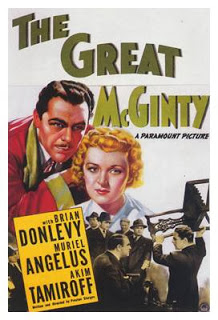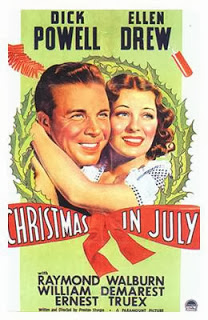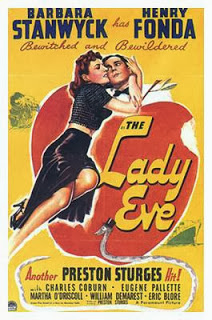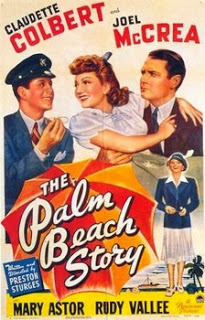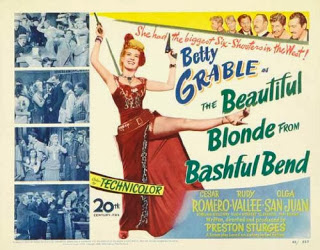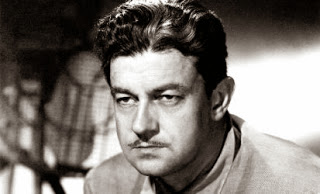Preston Sturges
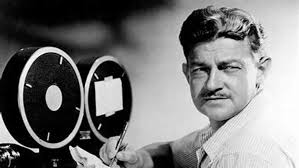
So I got my Preston Sturges’s urge out of my system by watching eleven of
his twelve directorial credits in around a week. It was a pleasure doing
so. I had seen the majority of his films decades ago, but there were a few
that I had never made the acquaintance of. Sturges is generally associated
with the Golden Age of screwball comedy, but his madhouse romps of rapid
spin your head patter, sexual tension, pratfalls and double takes, farce
and foolery, cynicism and sentimentality and portraits of a long gone America
that is manic, hectic, diverse, striving, democratic, full of different accents
and different hues are almost a genre of their own. Part of Sturges’s still
sterling reputation among film people (such as the Coen Brothers who used
the fictitious film title in Sullivan’s Travels “Oh Brother, Where Art Thou”
as the title of one of their films) is that he was one of the first directors
to write all of his own scripts, have a stock group of actors that he used
consistently through his career and at least for a while he was able to make
the films that he wanted to make without a lot of studio interference. In
this day and age I suppose he would be called an auteur, but back in those
days for a short period of time he was just the golden boy of the studio
with hit after hit. In a period from 1940 to 1944, he directed seven films,
all of which are usually included in most Top 100 critic lists of the top
comedies of all times. Then it all sort of went to hell.
Sturges was at heart a writer – first on Broadway where he had an enormous
hit (Strictly Dishonorable) that made him a wealthy man at an early age,
than moving to Hollywood in the early 1930’s and over a decade authoring
the scripts for many films, some of them classics – The Good Fairy, Easy
Living and Remember the Night - before persuading Paramount to allow him
to direct his first film, The Great McGinty, in 1940. He soon became one
of the highest paid people in Hollywood. The Great McGinty seems somewhat
of an odd choice for Sturges’s first film with its deep seated cynicism for
the American political system. It is a comedy in its totality but a bitter
tasting one. It tells the tale of a corrupt city boss (Akim Tamiroff) who
takes a homeless man (Brian Donlevy) and ushers him up the political ladder
from alderman to mayor and finally into the Governorship of the state; all
the time with both of them taking a crooked slice of all the money coming
in. When Donlevy’s character finally tries to do the right thing for the
people it leads to his downfall, disgrace and exile. For Sturges it was sort
of an antidote to the idealistic Capra film of the previous year, Mr. Smith
Goes to Washington. Donlevy wasn’t exactly a light comedian; more a gruff
force of nature with his stern take no prisoners style of acting, perhaps
best known to modern audiences in his role as Quatermass in two Hammer films
of the 1950’s. Sturges also began assembling his stock of character actors
with this film, many of whom show up in film after film, apparently to the
consternation of the studio who thought people would tire of seeing them
– but you never do (here is a page of them and the Sturges’ films they appear
in that some kind soul put together). The best known of them who appeared
in all of Sturges’s films until The Sin of Harold Diddlebock in 1947 is the
curmudgeonly William Demarest who became very familiar to audiences in the
1960’s for his role of Uncle Charley on My Three Sons.
Frank Capra had been the king of screwball comedy ever since It Happened
One Night in 1934. Before this Capra had already logged in a number of films
going back to 1926 but it was the screwball genre that made his name. He
followed up It Happened One Night with Mr. Deeds Goes to Town (1936), You
Can’t Take it With You (1938) and Mr. Smith Goes to Washington (1939) but
after the solemn and dour Meet John Doe (1940) and with the onset of WWII
Capra began to focus on directing propaganda documentaries to bolster the
morale of the home front. Arsenic and Old Lace was the one comedy he made
during the war years only to come back in 1946 with his most famous film,
It’s a Wonderful Life. Sturges adroitly stepped into the void and his next
film Christmas in July (1940) was a much more traditional feel good comedy
somewhat in the vein of a Capra film. Dick Powell who was in mid-career transition
from his juvenile roles in the Busby Berkely musicals to his later wonderful
tough guy roles such as Philip Marlowe in Murder, My Sweet (1946) plays a
nose to the grindstone office worker with dreams of winning it big. He thinks
he has when a few co-workers fake his winning a slogan contest for $25,000.
He goes on a big spending spree for his entire neighborhood, proposes to
his girlfriend and is promoted only to find out it was all a hoax. Sweet
and amusing, Sturges paints a touching tribute to the closeness of neighborhood
and community in those days.
Next in 1941 came a masterpiece. The Lady Eve is as near a perfect piece
of writing and directing as there has been for what it sets out to be, a
stylish sophisticated comedy that simmers with an undercurrent of sexuality
provided by the glowing Barbara Stanwyck. Sturges out Lubitsches Lubitsch,
the other great comedic director of this period, with a film so sleek and
funny that you just have to sit back in awe at the wonder of it all. Eve
(Stanwyck) and her father (Charles Coburn) are card sharks who ride the luxury
liners looking for dull pigeons to pluck of their money. Such a pigeon arrives
in the form of scholarly Charles Pike (Henry Fonda) the heir to an ale fortune
who has been up the Amazon for months looking for snakes. Perfection ensues.
If you have never been a fan of Stanwyck who can be very brittle and tough
at times (per Double Indemnity and Baby Face), watch this film and be forever
changed.
In the same year Sturges directed his second (and final) masterpiece, Sullivan’s
Travels. The film is stuffed to the brim with colliding conflicting ideas
and styles. On one level it is a satire of Hollywood, on another a social
commentary, on another a screwball sweet love story and on another an ode
to the human spirit. And then there is of course Veronica Lake at her loveliest
with her impudent stare and the trademark blond hair curving and cascading
down her face. John Sullivan (Joel McCrea) is an enormously successful comedy
director who has become tired of giving audiences slapstick comedies like
Ants in Your Pants and wants to make a serious film about the human condition.
When he spouts to the film studio heads, how can we make comedies with a
world falling apart around us, they tell him that he knows nothing about
misery and poverty so how can he possibly make a truthful film about the
subject. He agrees and so decides to disguise himself as a tramp and go into
the lost desperate world of the hobos and the destitute. He meets up with
a down on her luck actress and she tags along on the journey. Littered equally
with sparkling witty dialogue and foolish pratfalls, the film slowly inches
towards a resolution that is quietly profound, hopeful and humanistic.
At least for me, his next film The Palm Beach Story is the least interesting
of his run of comedies. It is a pretty straightforward adrenaline driven
madcap screwball comedy in which the unsuccessful Tom Jeffers (Joel McCrea)
chases after his wife (Claudette Colbert) who leaves New York City for Palm
Beach to find herself a wealthy new husband. She quickly finds a candidate
on a train when Rudy Vallee comes to her aid. His character could lend God
money at discount rates if he needed it. Vallee found himself in these sorts
of goody two shoe elitist roles many times and always performs them with
dashed good humor. He never seems to get the girls, which is odd when you
realize that Vallee is often considered perhaps the first huge pop star of
the 20th century. He was an enormously successful singer or crooner with
leagues of teenage girl fans in the late 20’s/early 30’s but this never translated
to his film roles.
The final two films during his successful run are usually paired together
because they both star Eddie Bracken and take place during the war in small
towns that envelop the story with a sense of community and belonging. Bracken
is an acquired taste that some may have trouble swallowing. His jittery tongue
tied nebbish persona is a peculiar one for a leading man, but Sturges throws
Bracken left right and center into these stories and they were both big hits
and Bracken became a household name. And he gets the girl in both films.
In The Miracle of Morgan’s Creek (1944) he plays insecure bank teller Norval
Jones who has been deeply in love with Trudy (the effervescent Betty Hutton)
since childhood. But his inability to get into the army has him feeling the
blues as she only has eyes for men in a uniform. On one night too much so,
as she gets inebriated, married and pregnant to a soldier whose name and
face she can’t even recall. Norval steps into the breach and nothing but
trouble comes out of it. For this period this was quite a controversial film
that Sturges somehow managed to slip by the Hayes Office censorship. In Hail
the Conquering Hero Bracken plays a similar character Woodrow Truesmith who
joined the marines only to be discharged for hay fever. But he was afraid
to tell his mother, girlfriend (Ella Raines) and town that he had failed
and so lies to them that he is over in the Pacific fighting. He meets up
with a troop of real marines (led by Demarest) and they decide to take him
home disguised as a marine who is just getting out of the service so that
he can be with his mother. Put on a uniform and then take it off after you
get home they tell him. What could go wrong? Pretty much everything. Infused
in this film is a pervading sense of duty and patriotism that beams in the
dark.
That turned out to be Sturges’s last box office success and he was to direct
only five more films even though he was only 46 years old at the time. In
a case where reality followed his own fiction, Sturges decided that he had
to make a serious film (The Great Moment, 1944) and clearly the film heads
were aghast at the thought of their money train going into serious fare.
They disliked the end result so much that they took the film into their own
hands and re-cut it. It is a very dull film but one has to wonder why the
story of the invention of anesthesia in the 1800’s so bewitched Sturges and
it is hard to imagine that his version of the film was much better. The film
was actually made prior to the two Eddie Bracken films but wasn't released
till afterwards. This and the continuing interference from the studio led
to Sturges parting ways with Paramount. When the film was finally released
it was a disaster at the box office.
He next partnered with his friend Howard Hughes but they did not remain friends
for long. Sturges lured the famous silent comedic star Harold Lloyd out of
retirement to perform in The Sin of Harold Diddlebock. Lloyd was of course
famous for his incredible stunts and athletic prowess (the iconic picture
of him hanging from a clock tower is part of film Americana) during the silent
era but he was never able to make the transition to talkies very successfully.
His last attempt had been in 1938 and it is not hard to see why success eluded
him. The Sin of Harold Diddlebock feels like a throwback to films of the
early 30’s – rather crude and clunky with Lloyd massacring every scene until
the final 30 minutes when the film hits a wonderful level of absurdity and
not coincidentally when Lloyd is allowed to exhibit his physical dexterity.
In a lengthy scene Lloyd who’s character has acquired a circus when he was
in a drunken stupor takes a lion for a walk in lower Manhattan to visit the
loathsome banker set and finally on to the ledge of a high raise building
where all nearly come to a sudden end. Just by watching the film you would
never guess it was a Preston Sturges film as it has none of his usual sophistication
and wit. The film was a box office thud and Hughes quickly took it out of
circulation and a few years later re-cut it and released it as Mad Wednesday.
There was another attempt at the partnership making the film Vendetta but
Sturges was fired by Hughes a few weeks into the project.
Sturges then went to work at Fox studios where he made two films that again
slouched at the box office and that was pretty much the end of his career.
The first one was Unfaithfully Yours which over time has been redeemed by
the critics as a fine comedy - (Pauline Kael later wrote "One of the most
sophisticated slapstick comedies ever made”) – and it is though it has sharp
edges and the warmth of a cobra. It is tour de force by Rex Harrison
as a symphony conductor who suspects his wife (Linda Darnell) of infidelity.
While conducting he concocts a plan to kill her and throw the blame on her
supposed lover. In his mind it is flawless but in execution it becomes a
plethora of pratfall pandemonium. Perhaps the failure of the film with audiences
can be directed at Harrison’s character who is a not a very likable fellow
who feels his class, breeding and genius entitles him to diminish all those
around him. That plays better today I expect.
The final film of Sturges’s that I watched (he was to make one more film
The French, They are a Funny Race in 1955 while in Europe that I can’t find
and I am not sure I want to) is the Betty Grable vehicle The Beautiful Blonde
from Bashful Bend in 1949. It was apparently the first major box office failure
of her career and though admittedly it is a slight film it is not a bad one
really; just a peculiar one from the urbane director. Grable plays a saloon
singing sharpshooter back in the old west that mistakenly wounds the judge
and has to flee to a small town and pretend to be an innocent school teacher.
It starts out in what appears to be a light musical comedy and then turns
into a gigantic shootout in which no one gets hit and then suddenly it is
over. It feels very abbreviated and only has two unambitious musical numbers
– one with her singing solo and the other with Rudy Vallee who once again
plays a nice wealthy guy who doesn’t get the girl.
It was a sad rapid decline for one of Hollywood’s brightest lights and it
is hard to understand how it came about so quickly. After his failures at
the box office, Hollywood turned on him and pretty much blacklisted him from
work. He was to die in 1959 of a heart attack at the Algonquin Hotel.


